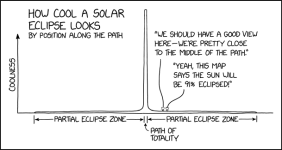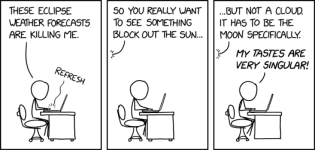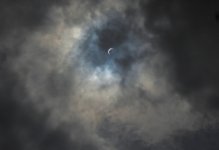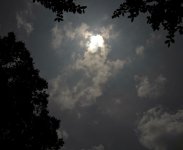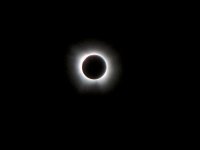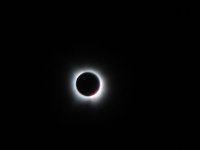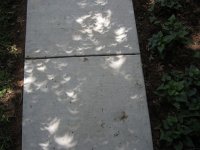For anyone who has not seen a solar eclipse, I highly recommend making the effort. I’ve been fortunate to have seen several, both full and partial. Unfortunately, I can’t drive at the moment due to medical conditions so I’ll miss this one. For the 2015 eclipse I drove an hour to a friend’s house which was not 50 yards from the exact path of the eclipse! It was such a great spot that another friend drove to TN from Maryland both to visit and to take photos. (No crowds, traffic, expense, just us!)
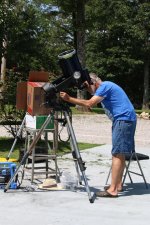
Several times in past years, when an eclipse occurred locally during a school day, I set up telescopes at schools and teachers would bring kids out and stand in line for a peek. A couple of times a friend and I would have a little discussion in a classroom before the eclipse using blackboard and balls to show how the moon and sun can line up at an eclipse, then go outside in time for the actual eclipse. The kids seemed to love it!
I generally set up two telescopes, the larger one on a motorized drive that automatically stays aligned with the sun. This one uses a professional multi-layer metal-film solar filter on the end of the scope which provides absolute safety. (NEVER use a filter on the eyepiece - if something goes wrong (burn through, shatter, etc) the viewer can instantly lose the sight in that eye.) Another advantage of a telescope with a quality objective filter is you can get a great view of any sunspots before and after the eclipse.
This is with the phone camera simply held up to the eyepiece of the big filtered telescope.
It's hard to hold it steady by hand!
One hint, which I didn't do here: zoom in a little on the camera or phone camera and you can get the entire field of view.
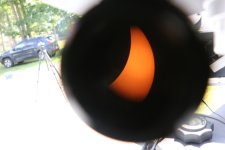
Using a better camera at the beginning of the eclipse, showing sunspots.
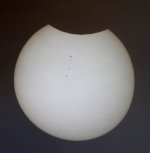
Even more popular is a smaller scope with a right-angle eyepiece. I set this on a tripod then project the image sideways into a cardboard box with a piece of white paper taped inside. This can project a rather large image of the eclipse. The big advantage is while just one person at a time can look through the large filtered telescope, multiple people can view the projected image in the box.
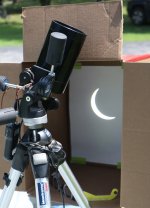
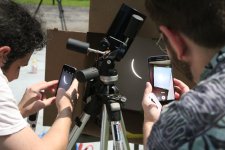
Another thing to look for - if in an area with trees with leaves over a concrete driveway or deck, during a partial or the beginning/end of a total eclipse look at the ground under the trees. Often the overlapping pinholes and each can project a small image of the eclipse on the ground. I’ve seen hundreds of little eclipses on sidewalks under such trees! I’ve even seen this by holding a sheet of paper behind a small bush covered with leaves.
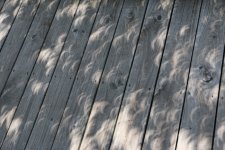
You can also hold a small hand-held scope or binocular in alignment with the sun and project an image of the eclipse onto a piece of white paper. We usually rest the binocular on the edge of the seat of a chair and put the paper on the floor. This is also a great way for more than one person to see the progress as the moon and sun intersect.
This was in Jaco, Costa Rica last year - partial eclipse projected from small roof prism binoculars, from the deck of our condo:
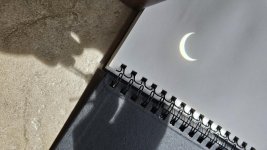
Another thing to look for, if you happen to be standing in an area with smooth paving or sidewalks is a series of parallel waves of ripples moving rapidly across the ground. This only happens twice during an eclipse and very briefly but is worth looking for. I’ve only see this once, during the Aug 2015 eclipse. It's very subtle so look closely! (Not easy to see on dirt or grass.)
This is what we saw during the best time of the total eclipse. This photo was taken by my friend from Maryland, using a long lens on a good digital SLR camera with a solar filter.
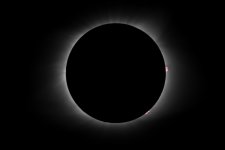
My good friend John L we visited for the eclipse, a fellow woodturner, made this for me afterwards: a commemorative hand mirror with a painted eclipse on the back. (One of his specialties is teaching classes on how to make hand mirrors) What a thoughtful guy!
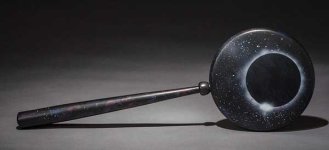
Good clean fun!
Now if a future topic turns to comets, I've got more photos.

JKJ













